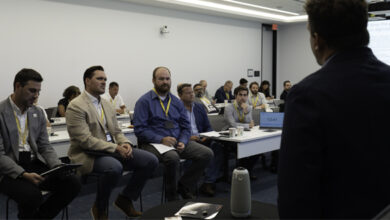A slimmer silhouette for drillships, semis
Smaller deepwater rigs based on slim-hole design target drilling in non-harsh environments
By Gavin Humphreys, Stena Drilling
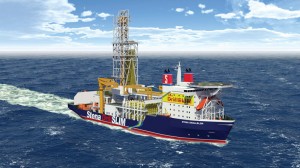
The current trends for highly mobile deepwater drilling are rigs suitable for ultra-deepwater, with complex geology and high pressures, which means requiring numerous casing strings, and with operations performed in extremely harsh environments. All these functional requirements for sixth-generation rigs come at a substantial increase in construction costs.
Looking at deepwater plays outside the Gulf of Mexico, such as Brazil, West Africa and Asia, however, a number of wells are drilled in water depths greater than 7,500 ft, with relatively low subsurface pressure regimes not requiring high mud weights or multiple casing strings and in relatively benign sea states.
For these types of wells, a harsh-environment sixth-generation rig, with its multi-casing capability and high mud weight functionalities, is not necessarily required.
As an alternative to the sixth-generation rig, Stena Drilling proposed a smaller drillship or semisubmersible, the DrillSLIM drillship (Figure 1) or DrillSLIM semisubmersible (Figure 2), which reduces construction costs by almost half compared with those of a current large newbuild drillship or semi. This should in turn reduce the costs of a typical exploration or development well by half to two-thirds, thus significantly reducing the costs to discover and develop hydrocarbons subsea.
Improving the economics on new subsea developments by increasing the number of wells (X conventional wells vs Y slim wells) will improve the field’s ultimate recovery and production profile. Field developments that were previously uneconomic due to reservoir properties may, with more wells and the use of managed pressure drilling (MPD) technology, become commercially viable.
Slim-hole drilling with casing design is based on using a 20-in. well conductor, followed by a cemented 13 3/8-in. surface casing. With a 13 5/8-in. x 10K BOP/riser system installed, the drilling reverts to conventional (i.e., 12 ¼-in. for 9 5/8-in. casing and 8 ½-in. for 7-in. casing or liner) using solid expandable casing (SEC) as the casing contingency string.
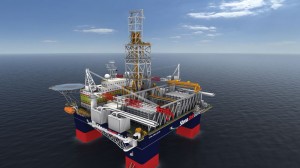
Well intervention may also consist of entering an existing subsea well to move the “drainage point” in the reservoir using through-tubing rotary drilling (TTRD) technology with drill pipe or coiled tubing to resurrect oil production and increase the reserves base.
The DrillSLIM drillship is based on the 150-meter x 30-meter Houlder slim-hole deepwater drillship. It is designed with a collapsible mast to transit by the most direct routes.
The DrillSLIM semisubmersible has the same drilling package and BOP/riser system but is based on a Keppel FELS DSS30 design hull. The requirement for a collapsible mast is removed.
The vessels are designed to drill slim wells (20-in. conductor, 13 3/8-in. surface casing, 9 5/8-in. casing, 7-in. liner across the reservoir). If a contingency casing is required, an 11 ¾-in. SEC expanded to 13 3/8-in. can be installed and cemented below the surface casing. Thereafter, the well is drilled to total depth (TD) conventionally and completed accordingly.
The units use a 13 5/8-in. ID, 10K riser with kill and choke lines from the seabed to surface with lower BOP (LBOP) with shear rams and lower marine riser package emergency disconnect at the seabed and an upper BOP (UBOP) at the surface. With the high-pressure riser and the UBOP, it can also be used for MPD and underbalanced operations (UBO) by the addition of a rotating control head (RCH) designed into the riser system and a flexible high-pressure hose tied into a permanent MPD choke manifold.
In addition to exploration and development drilling, the vessels would be capable of TTRD using drill pipe or coiled tubing and changing out completion strings where the tubing hanger is 11 ¾ in. or smaller. Both vessels also would be capable of executing well intervention activities.
Basis of design
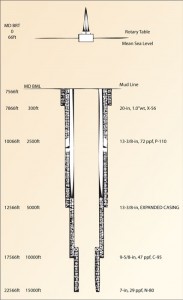
DrillSLIM is designed to meet three primary requirements: handling the riser system; drilling MPD, UBO or dual-gradient riserless drilling (DGD); and drilling, completing and intervening in subsea wells.
These features were incorporated to handle the riser system:
• Hoisting capacity to suit the riser joint length and the total weight of the riser and BOPs in seawater;
• Tensioners for 7,500-ft riser containing 16-ppg drilling fluid; and
• Facilities for handling and racking all of the riser joints onboard.
To drill MPD, UBO or DGD, these adaptations were made:
• The MPD/UBO choke manifold is pre-built in the vessel substructure of the drillship or semisubmersible;
• A trip saver is installed to support a 9 5/8-in. casing with a subsea pump (designed to take fluid returns while drilling DGD); and
• A dummy flowline is built in the substructure to close the flow loop while drilling DGD.
To make the vessels capable of drilling, completing and intervening in subsea wells, these features were designed in:
• The ability to drill a 15,000-ft slim well below seabed in 7,500-ft water depth;
• The ability to use modern drilling techniques such as MPD and UBO;
• Hoisting capacity to run and pull 15,000 ft of drill pipe and the true vertical buoyant weight of the heaviest casing, including an allowance for stuck casing;
• Active pit tank capacity to fully displace the largest hole volume over to another mud or brine system;
• Full mud treatment and cuttings containment with the ability to mix new mud and brine simultaneously;
• Sufficient liquid and dry bulk storage;
• Mast racking capacity for the full drill string;
• Mast collapsible to navigate the Panama and Suez Canals and under the bridge in the Bosphorous (DrillSLIM drillship only); and
• Deck space and services for electric and slick line, cementing, well testing, well stimulation, coiled tubing, MPD/UBD operations and drill cuttings treatment.
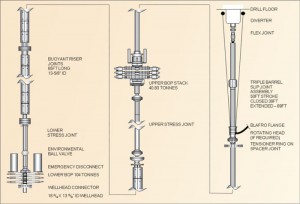
The DrillSLIM drilling equipment package functionality is based on a 15,000-ft exploration well using expandable pipe (as contingency) in a maximum water depth of 7,500 ft and a well TD of 22,566 ft measured depth below the rotary table (Figure 3).
The general principle judged against a conventional well is that the first casing run and cemented prior to running BOPs will be one API size smaller (e.g., 13 3/8 in. vs 20 in.).
If required, the expandable liner (generally 11 ¾-in. OD) is expanded to seal at the junction of the 13 3/8-in. shoe. This makes the DrillSLIM 13 3/8-in. casing shoe depth equivalent to that of a standard casing design. After setting surface casing with the 18 ¾-in. x 13 5/8-in. ID subsea wellhead, the LBOPs, riser system and UBOP are run.
If an intermediate expandable liner is required, the next hole section would be underreamed for an expandable 13 3/8-in. liner to be run, cemented, expanded and then sealed into the previous surface casing.
The well would then be drilled with a 12 ¼-in. bit for the 9 5/8-in. production casing at approximately 17,000 ft and finished with 8 ½-in. hole and 7-in. production liner at approximately 22,500 ft.
Drilling package details
Hoisting and handling Equipment
The heaviest load of 355 tons occurs when the 7,500-ft of riser, two sets of BOPs, ancillary and traveling equipment are run. A 500-ton hoist rating is used to allow some margin of safety.
A single mast is used with a ram-type hoist with a clear working height for drilling with a top drive and racking back triple joints of drill pipe.
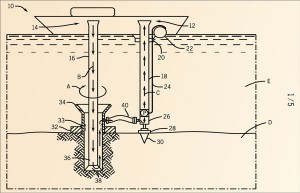
The drill string motion compensation is integrated into the dead line. The mast has a hydraulic racking system with setback for 22,500 ft of 5-in. drill pipe and drill collars and a remote-operated iron roughneck is provided on the drill floor for tubular makeup and breakout.
Below the drill floor is a skidding and trolley system, providing handling and storage for the 2 x 13 5/8-in. LBOP and UBOP stacks and up to two subsea Christmas trees.
At moonpool level, there is a retractable dummy riser spider trolley to hang off the BOP while the load ring and telescopic joints are installed. There are three hydraulic knuckle boom cranes and two horizontal catwalks, one forward for riser transport and one aft for drill pipe/casing, both at drill floor elevation.
Rotating equipment
The top drive is a 500-ton AC motor driven with a conventional 49 ½-in. rotary table and driven by a hydraulic motor for limited rotational capability.
Mud, solids control and cement systems
The active pit system is 6,460 bbl plus five 60-bbl treatment tanks. The active pits are split in half for two independent mud/brine systems with two automated mud/brine-mixing facilities for concurrent operations. Liquid storage includes 9,750 bbl of drill water, 2,140 bbl of base oil and 1,570 bbl of brine.
Three conventional triplex pumps with 7,500-psi fluid ends will provide for all downhole pumping operations. Solids control is provided by four linear-motion shale shakers, a de-sander, a de-silter, a de-gasser and space and plumbing for two third-party supplied centrifuges. Solids disposal is via one double screw conveyor feeding into a big-bag turntable station. Dry bulk storage is 6 x 60-cu metertanks (a bentonite, three barite and two cement) with 3 x 6 cu meter surge tanks. The cement unit is third-party-supplied and provides pressure-testing and emergency pumping services.
Utility systems
The electrical power system uses variable-speed AC drives for the mud pumps and top drive, with a normal drilling load of 3.0 MW. The hoisting system is hydraulically powered through a central hydraulic power unit.
Well control equipment (riser & BOPs)
The well control equipment, from the bottom up, consists of: LBOP, an emergency disconnect lower riser package (LRP), lower stress joint, high-pressure riser, upper stress joint, UBOP, high pressure spacer joint with load ring, Balfro flange and a diverter system (Figure 4). An RCH is installed on top of the spacer joint if MPD or UBO are performed.
The 13 5/8-in. ID x 10K riser with kill and choke lines is a hybrid design to give a 10,000-psi burst rating and to comply with stringent dimensional requirements for handling and storage on the deck of the drillship (to keep the ship size to a minimum).
The riser is 7,500 ft of 13 5/8-in. ID x 10K (120 joints) with two choke/kill lines. The joints are 65-ft long with high-strength connectors, weigh +/-21 T (dry) and are 45-in. OD with buoyancy. The riser is supported by a substructure mounted tensioner system, rated to 2.4 million lbs with 14.0-ppg (1.68-SG) fluid inside the riser.
The 13 5/8-in. LBOP and LRP (10,000-psi rated) enable the well to be closed in at seabed level and the high-pressure riser to be disconnected. It includes from the bottom up: a subsea wellhead or tree connector and three sets of rams (1x pipe rams to hang-off drill pipe; 2x blind shear rams with fail-safe closed connections to monitor pressure build-up in the event the well is closed in on the blind rams). The hydraulic disconnect package or LRP has an inverted connector with acoustic control backup and has a high-pressure ball valve to contain the mud during emergency disconnect.
The conventional 13 5/8-in. UBOP is installed at the top of the high-pressure riser (just below sea level) and includes from the bottom up: three sets of 10,000-psi rams (1x 9 5/8-in. casing ram, five 2x 2 7/8-in. variable bore rams) and a 5,000-psi annular preventer.
The LBOP and LRP are controlled by a multiplex system with acoustic backup, including: duplicate umbilical control reels and a modular emergency subsea accumulator pack (set on seabed), ROV connected. The UBOP is controlled by a pilot hydraulic control system. The controls for both the UBOP and LBOP are adjacent to each other on the same panels.
A conventional choke/kill manifold with inlets from the UBOP and an independent choke manifold with self-adjusting chokes for MPD and UBO are installed.
Advanced technologies
Currently neither MPD nor UBO are routinely carried out from floating rigs due to the lack of pressure integrity of the low-pressure marine riser. Some pressurized interventions are being carried out from floating rigs, but these involve dedicated intervention risers with increased costs. Limited MPD is performed where an RCH is installed on a collapsed telescopic joint where pressurized mud cap drilling technology is required.
With DrillSLIM, the riser and the UBOP act as an extension to the wellbore for drilling operations, facilitating MPD and UBD operations. Similarly, the riser acts as a very long lubricator for pressurized well interventions by also using the LBOP and the UBOP together with an RCH for MPD and UBD drilling and even TTRD well intervention applications.
Managed pressure drilling
There are several ways to achieve the required downhole hydrostatic pressure for MPD. The easiest is to drill with a light fluid and apply backpressure via the choke. An alternative method, DGD, is achieved by injecting a light fluid or gas into the return mud annulus at the mud line, thus reducing the hydrostatic down to the mud line. MPD can reduce drilling problems and enable deeper casing seats or longer section lengths (compared with using a conventional mud system) and can eliminate casing strings.
Underbalanced drilling
This is mainly used for drilling through the reservoir. As the well is flowing while drilling, it can provide real-time reservoir characterization, thus optimizing the completion design and reducing formation damage to increase initial production.
Dual-gradient drilling
The current method to set surface casing in deepwater is to drill the top hole in open water with water, allowing drilling returns to settle on the seabed. In some regions, there can be up to three casings set in this way prior to running the subsea BOPs. This method of drilling is extremely expensive and time consuming. As an alternative, DGD involves drilling the top hole in open water and requires a temporary template set on the seabed with a subsea pump pumping return drilling fluids to surface, creating a closed-loop drilling system. The top holes can then be drilled using more sophisticated muds, improving hole cleaning and borehole stability.
The effect is that top holes can be drilled deeper with surface casing cemented at the appropriate depth for the shoe strength to drill ahead and enable the drilling of a slimmer well.
Summary
The current trend for highly mobile deepwater rigs is for bigger drillships and semisubmersibles with increasing building costs. Stena Drilling’s proposed smaller drillship or semisubmersible is expected to cost substantially less. It would require only two drill crews (one mast), so the crew rate would be approximately 70% that of a larger drillship. The daily spread rate is anticipated to be half to two-thirds of that of a large drillship.
With the smaller well design, drilling optimization is expected to be improved as there is less rock to drill, less consumables such as casing, drilling fluids and cement, that will substantially reduce these aspects of well costs.
Overall, however, the reduced spread rate and the lower well consumable costs should enable a typical dry hole well cost to be reduced by half to two-thirds from a conventional well.
This means that in deepwater regions, where exploration success rates are low, discovery and development well costs has the potential to be significantly reduced. MPD, DGD and UBO drilling technologies can also reduce overall field development costs, particularly in fields where reservoir characteristics have made the field development economically marginal.
The economic benefit of moving the “drainage point” in a reservoir through TTRD technology to increase the field’s reserves base and increase the field’s ultimate recovery also should not be underestimated.



